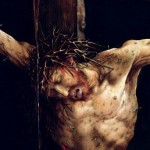by Fr. Patrick Henry Reardon
 When we speak of excruciating pain, we do well to look at the etymology of that adjective:
When we speak of excruciating pain, we do well to look at the etymology of that adjective:
ex cruce,
“out of the cross.”
It is nearly impossible to exaggerate what the Savior suffered on the cross.
Whether the cause of Jesus’ death was asphyxiation, or hypercarbia, or hypovolemic shock, or heart failure, or exsanguination, or total physical exhaustion brought on by tetanic contractions throughout his entire body—or any combination of these, or any other plausible suggestion—the astounding fact is that Jesus, at the very end,
“cried out again with a loud voice.”
From a medical perspective, this is surprising.
Surely, it was the last thing anyone on Calvary could have expected. This “loud voice” demonstrated, nonetheless, the truth of the Savior’s claim:
“I lay down my life that I may take it again. No one takes it from me, but I lay it down of myself. I have power to lay it down, and I have power to take it again” (John 10:17-18).
Jesus did not simply die. He willingly tasted death, according to the Epistle to the Hebrews. He deliberately went through the actual experience of dying. The gospels indicate that Jesus was conscious and self-aware to the end. There was no disorientation, no coma, no mental befuddlement. The gospels testify, in fact, that he declined a narcotic that would have disguised and muted his pain. Jesus knew what he was doing.
He knew, moreover, why he was doing it. It is remarkable that his disciples—then and now—express the conviction that Jesus, in the act of dying, thought of them and poured out his life for each of them. This is the testimony of the Epistle to the Hebrews:
“But we see Jesus, who was made a little lower than the angels, for the suffering of death crowned with glory and honor, that he, by the grace of God, might taste death for every person” (Hebrews 2:9 emphasis added).
Hebrews says,
“for every person” (hyper pantos),
not
“for all persons” (hyper panton).
Although Jesus certainly died “for everyone,” it is important to remark that he died “for every one.” In the mind and intent of Jesus, the beneficiaries of his death were not an amorphous group.
The Good Shepherd, who gives his life for the sheep,
“calls his own sheep by name and leads them out” (John 10:3 emphasis added).
More than two decades after the event, someone who had not known Jesus on earth, was so confident on this point that he declared,
“I have been crucified with Christ; it is no longer I who live, but Christ lives in me; and my life in the flesh I live now by faith of God’s Son, who loved me and gave himself for me” (Galatians 2:20 emphasis added).
Such has been the conviction of believers down through the ages, those millions in the flesh, who have declared, unto their dying breath,
“He loved me. He gave himself for me.”
The description of the Savior’s death in the Gospel of John shows every sign of conveying the testimony of an eyewitness. Indeed, the Sacred Text itself calls attention to the first-hand reliability of this testimony:
“And he who has seen has testified, and his testimony is true; and he knows that he is telling the truth, so that you may believe” (John 19:35).
John alone includes the gentle detail,
“And bowing his head . . .” (19:30).
Two further details in John’s testimony seem worthy of special examination.
First, John affirms that Jesus
“handed over the Spirit”—paredoken to Pnevma.
That is to say, the very breath, pnevma, with which Jesus expired on the Cross becomes for John the symbol and transmission of the Holy Spirit that he confers on the Church gathered beneath his cross.
Second, John records another detail of the scene not mentioned by the other evangelists:
“But one of the soldiers pierced his side with a spear, and immediately blood and water came out” (19:34).
All together, then, John speaks of three things issuing forth from the immolated body of the Savior: the Spirit, the water, and the blood. These three components—the Spirit, the water, and the blood—appear also in the cover letter for John’s Gospel as the “three witnesses” of the Christian mystery:
“And there are three that testify: the Spirit and the water and the blood; and these three are one” (1 John 5:8).
These things have to do with the gathering of the Church at the foot of the Cross.
